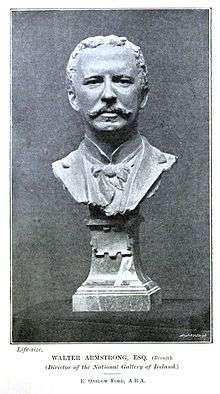Walter Armstrong (art historian)

Sir Walter Armstrong (7 February 1850 Hawick, Roxburghshire – 8 August 1918 London) was a British art historian and author.[1]
Armstrong was born in 1850, was educated at Harrow and Exeter College, Oxford, and for some 10 years after 1880 was art critic to several newspapers, such as the Pall Mall Gazette, the Manchester Guardian, and the old Manchester Examiner. He made his mark in the art world, and was consulted by students and collectors, becoming an authority especially on Dutch 17th-century and English 18th-century painting. Several fine collections, of which that of Mr. S. Joseph, was one, were mainly formed under his advice.
In 1892, he succeeded the late Henry Doyle as Director of the National Gallery of Ireland in Dublin, which his predecessor had reorganized and developed; and in this post Armstrong remained for over 20 years, his services recognized by a knighthood in 1899. During his time in Dublin he wrote many books, among which his stately volumes on Sir Joshua Reynolds, Gainsborough, and Raeburn were the chief, that held a position of authority for many years afterwards. Earlier and later he wrote columns on men so various as Peter De Wint, Velasquez, and Sir Thomas Lawrence, and a book of "Notes" on the National Gallery, containing many suggestive criticisms. Armstrong was said to be quick at absorbing the essential points of contemporary researchers and in judging them by the aid of a keen eye and a clear brain.
In 1873 he married Miss Ferard of Ascot Place, of which there was issue, and he died in Westminster on 8 August 1918.[2]
References
- ↑ "Armstrong, Sir Walter". Who's Who. Vol. 59. 1907. p. 55.
- ↑ "Death of Sir Walter Armstrong, art critic and writer". The Times. London. p. 9. Retrieved 30 April 2012.
External links
-
 Works written by or about Walter Armstrong at Wikisource
Works written by or about Walter Armstrong at Wikisource - Web page on Walter Armstrong at the National Gallery of Ireland
- Works by Walter Armstrong at Project Gutenberg
- Works by or about Walter Armstrong at Internet Archive